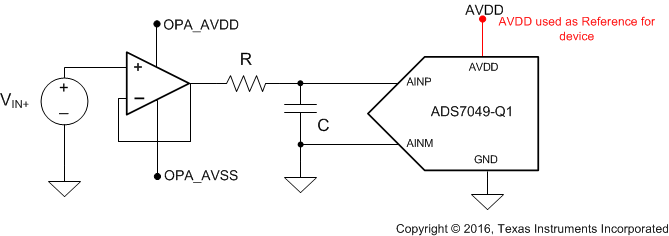ZHCSFM9 November 2016 ADS7049-Q1
PRODUCTION DATA.
1 特性
- 适用于汽车电子 应用
- 具有符合 AEC-Q100 的下列结果:
- 器件温度 1 级:-40°C 至 125°C 的环境运行温度范围
- 器件人体放电模型 (HBM) 静电放电 (ESD) 分类等级 ±2000V
- 器件带电器件模型 (CDM) 静电放电 (ESD) 分类等级 ±1000V
- 超低功耗:
- 2MSPS、AVDD 为 3V 时的功耗为 1.38mW(最大值)
- 1kSPS、AVDD 为 3V 时的功耗低于 1µW
- 微型封装:
- 8 引脚超薄小外形尺寸 (VSSOP) 封装:2.30mm × 2.00mm
- 吞吐量为 2MSPS 且零延迟
- 宽工作电压范围:
- AVDD:2.35V 至 3.6V
- DVDD:1.65V 至 3.6V(与 AVDD 无关)
- 温度范围:-40°C 至 +125°C
- 出色的性能:
- 12 位分辨率且无丟码 (NMC)
- ±0.5 LSB DNL;±0.5 LSB INL
- 70dB 的信噪比 (SNR)(3V AVDD 时)
- –80dB 的总谐波失真 (THD)(3V AVDD 时)
- 单极输入范围:0V 至 AVDD
- 集成偏移校准
- 兼容 SPI 的串行接口:32MHz
- 符合 JESD8-7A 标准的数字 I/O
2 应用
- 车用信息娱乐
- 车用传感器
- 液位传感器
- 超声波流量计
- 电机控制
- 便携式医疗设备
3 说明
ADS7049-Q1 器件是一款符合汽车类 Q100 标准的 12 位、2MSPS 模数转换器 (ADC)。此器件支持宽范围的模拟输入电压(2.35V 至 3.6V),并且包括一个基于电容器且内置采样保持电路的 SAR ADC。串行外设接口 (SPI) 兼容串口由 CS 和 SCLK 信号控制。输入信号在 CS 下降沿进行采样,SCLK 用于转换和串行数据输出。此器件支持宽范围的数字电源(1.65V 至 3.6V),可直接连接到各类主机控制器。ADS7049-Q1 符合 JESD8-7A 标准的标称 DVDD 范围(1.65V 至 1.95V)。
ADS7049-Q1 采用 8 引脚微型 VSSOP 封装,额定工作温度范围为 –40°C 至 +125°C。ADS7049-Q1 采样速率较快,采用微型封装并具有低功耗特性,适用于空间受限的汽车类快速扫描 应用。
器件信息(1)
| 部件名称 | 封装 | 封装尺寸(标称值) |
|---|---|---|
| ADS7049-Q1 | 超薄小外形尺寸封装 (VSSOP)(8) | 2.30mm x 2.00mm |
- 要了解所有可用封装,请见数据表末尾的可订购产品附录。
典型应用
